Contents
- History and Evolution of Dartboards
- Different Types of Dartboards
- Factors to Consider When Selecting a Dartboard
- Setting Up Your Dartboard: Indoor vs Outdoor
- Size and Regulation Guidelines
- The Best Dartboard Brands and Models for Serious Players
- Mounting and Installation Best Practices
- Customizing Your Dartboard Surround
- Maintaining and Caring for Your Dartboard
- Interactive Features in Modern Dartboards
- Selecting the Right Darts for Your Dartboard
- The Role of Dartboards in Competitive Play
- The Future of Dartboards: Trends and Innovations
- Perfecting Your Game with the Ideal Dartboard
Hitting the Bullseye with Dartboard Knowledge
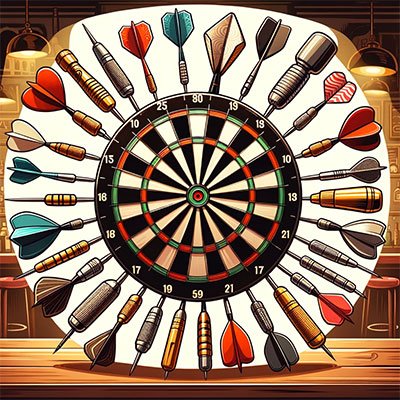
In the world of darts, the choice of dartboard can be as critical as the darts themselves. This guide aims to be your trusty companion, leading you through the maze of dartboard types and helping you select the perfect board for your needs. Whether you’re a seasoned pro aiming for championship glory or a casual player looking to enhance your game room, understanding the nuances of different dartboards is key to hitting the bullseye in your darts journey.
From the classic bristle boards gracing the pubs of the UK to the high-tech electronic boards used in competitive leagues, the world of dartboards is as diverse as it is fascinating. So, let’s embark on this journey together, exploring the rich history, varied types, and the essential considerations when choosing your ideal dartboard.
History and Evolution of Dartboards
Dartboards have come a long way from their humble beginnings. The early versions were mere cross-sections of tree trunks, where the natural rings of the wood served as makeshift targets. This rustic beginning laid the foundation for what would become a globally beloved game.
As we moved through the centuries, dartboards evolved significantly. By the early 20th century, we saw the emergence of the now-classic bristle dartboard, a design that revolutionized the game. These boards, made from compressed sisal fibers, offered enhanced durability and self-healing properties, making them a favourite in pubs and tournament settings alike.
The latter part of the 20th century brought the advent of electronic dartboards, a leap that mirrored the technological advancements of the era. These boards, equipped with automatic scoring and sound effects, have broadened the appeal of darts, making it accessible to a wider audience including casual players and tech enthusiasts.
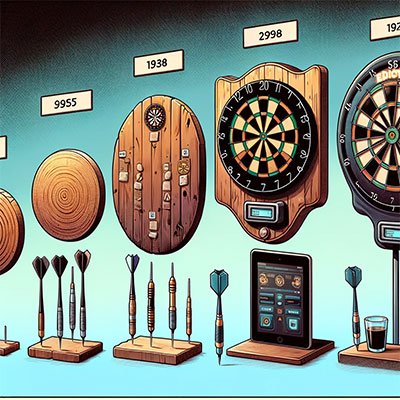
Understanding this evolution is not just about tracing the history of a game, but recognizing how each advancement has made the game more accessible, competitive, and enjoyable.
Different Types of Dartboards
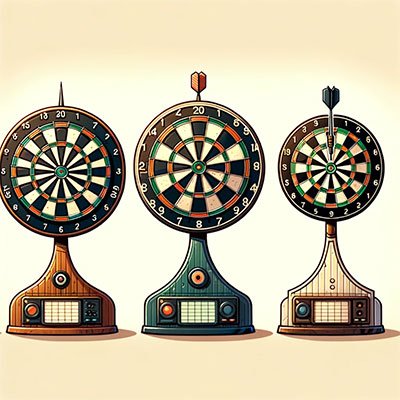
The world of dartboards is rich and varied, catering to players of all preferences and skill levels. Here, we delve into the most popular types of dartboards you’ll encounter:
- Bristle Dartboards: The classic choice for professionals and enthusiasts, bristle dartboards are renowned for their durability and self-healing properties. Ideal for steel-tip darts, these boards are the standard in tournaments and pubs.
- Electronic Dartboards: Perfect for families and casual players, electronic dartboards offer a modern twist with automatic scoring and sound effects. They are generally used with softer tip darts and are a great choice for safe, interactive fun.
- Magnetic Dartboards: Offering the ultimate in safety and ease of use, magnetic dartboards are excellent for young players or those new to the game. These boards use flat, magnetic darts, eliminating the risk of injury and damage to walls.
- Coiled Paper Dartboards: A more economical option, these dartboards are made by coiling paper tightly. While they don’t offer the same longevity as bristle boards, they’re a good choice for casual play and beginners.
- Wood Dartboards: Harking back to the origins of the game, wood dartboards have a traditional charm. Mostly used in specific dart games and by purists, they require regular maintenance but offer a unique playing experience.
Each type of dartboard brings its own set of characteristics and benefits. Whether you’re playing for fun, training for a tournament, or anything in between, there’s a dartboard just right for your needs.
For more on modern electronic boards, don’t miss our detailed guide, Electronic Dartboards: A Comprehensive Guide.
Factors to Consider When Selecting a Dartboard
Selecting the right dartboard is crucial to enhancing your darts experience. Here are the key factors you should consider:
- Usage: Determine the primary use of your dartboard. Is it for professional play, casual games at home, or training purposes? Each use case might favour a different type of dartboard.
- Material Quality: The durability and performance of a dartboard are largely influenced by its material. Bristle boards, for instance, are known for their longevity and are preferred in professional settings.
- Durability: Consider how often the board will be used. Frequent play requires a board that can withstand regular wear and tear.
- Maintenance Requirements: Different dartboards require varying levels of maintenance. Bristle boards, for instance, need regular brushing, while electronic boards might need battery changes or software updates.
- Budget: Dartboards come in a range of prices. It’s important to find a balance between quality and affordability.
For a deeper dive into dartboard materials, check out our guide on Selecting the Ideal Dartboard Material for a Perfect Game.
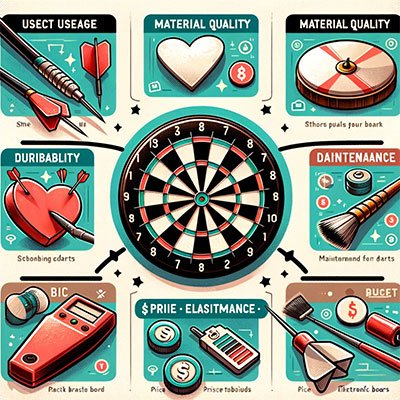
Setting Up Your Dartboard: Indoor vs Outdoor
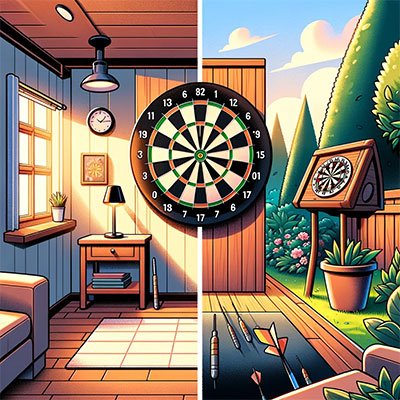
The location where you set up your dartboard can greatly impact your playing experience. Here’s what to consider for indoor and outdoor setups:
- Indoor Dartboard Setup: Indoors, you have more control over lighting and environmental factors. It’s also safer and more convenient for regular practice. However, space might be limited, and you need to consider wall protection.
- Outdoor Dartboard Setup: Playing darts outside can be incredibly enjoyable, especially in good weather. It adds a fresh dimension to your game. But, outdoor elements like wind and moisture can affect both your play and the dartboard’s condition.
Regardless of your choice, ensuring the right setup is key to an optimal darts experience. For a detailed comparison and tips, check out our article on Dartboard Setup: Indoor vs Outdoor.
Size and Regulation Guidelines
Understanding the official size and regulation guidelines for dartboards is crucial, especially for players looking to compete or mimic professional play conditions. Here’s what you need to know:
- Dartboard Diameter: The standard diameter for a quality dartboard is 17.75 inches (450mm). This size ensures a consistent playing experience across different settings.
- Double and Triple Ring Dimensions: These rings are key areas in the game of darts, and their dimensions are regulated. The double ring is 0.32 inches (8mm) wide, and the triple ring is 0.32 inches (8mm) wide.
- Bullseye Specifications: The bullseye, or the ’25’ and ’50’ score areas, have specific sizes. The outer bull (25) has a diameter of 1.26 inches (32mm), and the inner bull (50) is 0.5 inches (12.7mm).
- Mounting Height and Throwing Distance: The dartboard should be mounted so the bullseye is at 5 feet 8 inches (173cm) off the ground. The oche, or throwing line, should be 7 feet 9.25 inches (237cm) from the dartboard’s face.
For more detailed information on dartboard specifications, refer to our Dartboard Size and Regulation Guidelines.
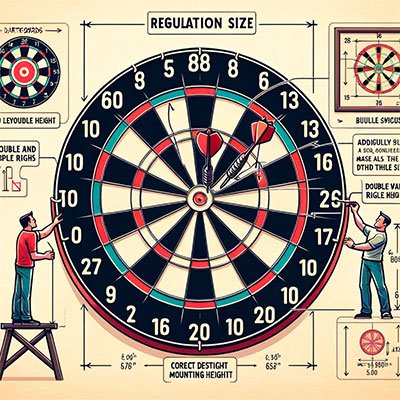
The Best Dartboard Brands and Models for Serious Players
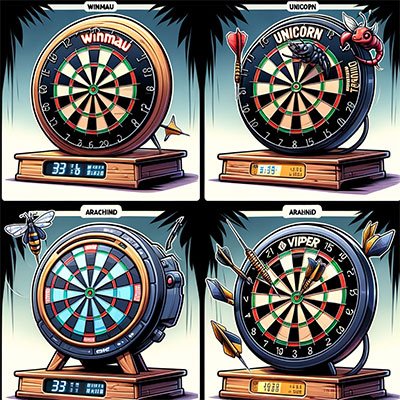
When it comes to serious play, not all dartboards are created equal. The market offers a variety of brands and models, each with its unique features and benefits. Here, we explore some of the top choices for serious dart players:
- Winmau: Known for its high-quality bristle boards, Winmau is a favourite among professional players. Their boards are renowned for durability and exceptional playability.
- Unicorn: Another leading name in the dart world, Unicorn offers a range of boards catering to all levels of play, known for their innovation and quality.
- Arachnid: For those who prefer electronic dartboards, Arachnid stands out with its advanced technology and user-friendly interfaces.
- Viper: Viper dartboards are popular for both casual and competitive play, offering a good balance of quality and affordability.
Choosing the right brand and model can significantly enhance your playing experience. It’s about finding the board that best suits your style and aspirations in the game.
For a deeper look into the best dartboard brands and models, check out our extensive review at Best Dartboard Brands and Models for Serious Players.
Mounting and Installation Best Practices
Proper mounting and installation of your dartboard are essential for both safety and optimal play. Here are some best practices to follow:
- Choose the Right Location: Find a spot that’s free from foot traffic and has enough space for players to throw comfortably. Ensure there’s adequate lighting and a clear line of sight.
- Mounting Height: The bullseye should be at 5 feet 8 inches (173cm) from the ground. This is the standard height used in professional play.
- Secure Mounting: Ensure the dartboard is securely mounted to the wall. Many boards come with mounting brackets for this purpose. The board should be stable and not wobble when darts hit.
- Protect Your Walls: Consider installing a backboard or a dartboard surround to protect the wall around the dartboard from stray darts.
- Flooring Considerations: To protect your floors and darts, place a dart mat or a similar protective layer on the floor.
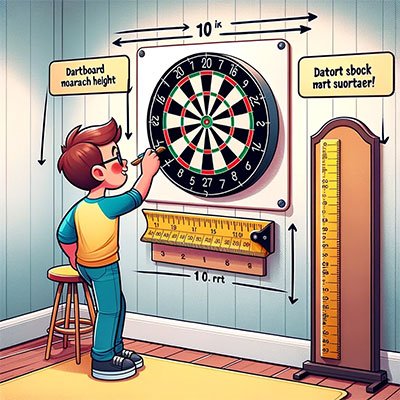
For more detailed guidance on mounting your dartboard, explore our article on The Science of Dartboard Mounting: Best Practices
Customizing Your Dartboard Surround
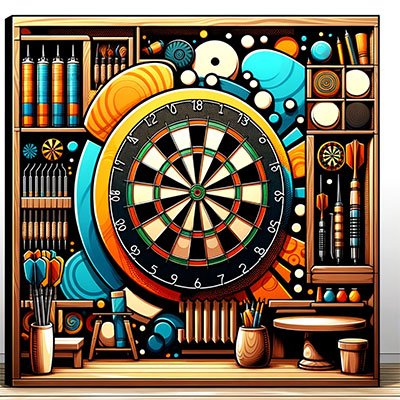
Proper maintenance and care can significantly extend the life of your dartboard, ensuring consistent play and preserving its aesthetic appeal. Here are some key tips:
- Regular Cleaning: Gently brush the surface of the dartboard to remove dust and chalk marks. Avoid using water or harsh cleaning agents.
- Rotate the Board: Regularly rotating your dartboard ensures even wear. This is especially important for bristle boards, where certain areas may see more hits.
- Avoid Moisture and Extreme Temperatures: Store your dartboard in a dry, climate-controlled environment to prevent warping and damage.
- Replace Worn-Out Parts: For electronic dartboards, be vigilant about replacing worn-out parts like segments or lights.
- Checking for Damage: Regularly inspect your dartboard for signs of wear or damage, and replace it if it becomes too worn for fair play.
For comprehensive tips on customizing your dartboard, take a look at our detailed guide on Customizing your dartboard.
Maintaining and Caring for Your Dartboard
Proper maintenance and care can significantly extend the life of your dartboard, ensuring consistent play and preserving its aesthetic appeal. Here are some key tips:
- Regular Cleaning: Gently brush the surface of the dartboard to remove dust and chalk marks. Avoid using water or harsh cleaning agents.
- Rotate the Board: Regularly rotating your dartboard ensures even wear. This is especially important for bristle boards, where certain areas may see more hits.
- Avoid Moisture and Extreme Temperatures: Store your dartboard in a dry, climate-controlled environment to prevent warping and damage.
- Replace Worn-Out Parts: For electronic dartboards, be vigilant about replacing worn-out parts like segments or lights.
- Checking for Damage: Regularly inspect your dartboard for signs of wear or damage, and replace it if it becomes too worn for fair play.
For comprehensive tips on dartboard maintenance, take a look at our detailed guide on Maintaining and Caring for Your Dartboard.
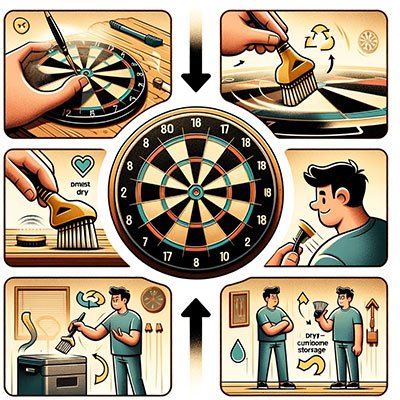
Interactive Features in Modern Dartboards

The intersection of technology and darts has led to the development of dartboards with interactive features, enhancing both the playing and learning experience. Here’s what modern dartboards offer:
- Automatic Scoring: Electronic dartboards come with digital scoring systems, making scorekeeping effortless and accurate.
- Sound Effects and Voice Prompts: Many modern boards include sound effects and voice prompts, adding an extra layer of excitement and interactivity to the game.
- Connectivity and Apps: Advanced boards can connect to apps, allowing players to track their progress, play online with others, and access a wealth of statistical analysis.
- Training Modes: Some electronic dartboards offer training modes with games designed to improve specific aspects of your play, such as accuracy and consistency.
These interactive features not only make the game more engaging but also provide valuable tools for players looking to improve their skills.
Are you satisfied with this section on interactive features in modern dartboards? Would you like an image to accompany it?
Selecting the Right Darts for Your Dartboard
Choosing the right darts is as important as selecting the dartboard itself. The compatibility of darts with your dartboard can significantly affect your game. Here are some considerations:
- Dart Weight and Balance: The weight and balance of the darts should complement the dartboard type. Heavier darts may suit bristle boards, while lighter ones are often preferred for electronic boards.
- Tip Material: Steel tips are ideal for bristle boards, whereas soft tips are necessary for electronic dartboards to avoid damaging the delicate electronics.
- Grip and Shaft: The grip and shaft should suit your throwing style and provide the right level of control and stability.
- Aesthetics: While functionality is key, the design of the darts can also add to your enjoyment of the game.
For more on selecting the right darts, especially in relation to different types of dartboards, explore our guide on Selecting the Right Darts for Your Playing Style.
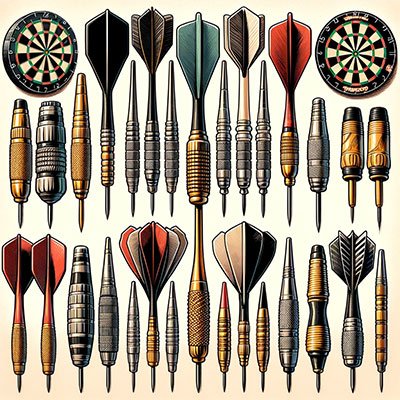
The Role of Dartboards in Competitive Play
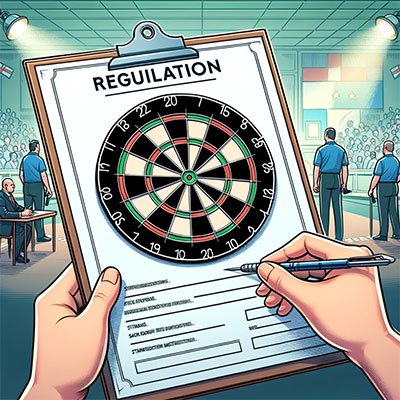
The choice of dartboard plays a pivotal role in competitive darts. It’s not just about personal preference, but also about adhering to standards that ensure fair play. Here’s what to consider:
- Regulation Dartboards: In tournaments, standardization of dartboards is crucial. This includes aspects like size, material, and layout, ensuring a level playing field for all competitors.
- Consistency and Fairness: High-quality, well-maintained boards contribute to the consistency of play. This is vital in competitions where precision and fairness are paramount.
- Player Adaptation: Competitors often need to adapt their play to different dartboards, a skill that can be as important as their throwing technique.
The dartboard’s role in competitive play underscores the importance of standardization and quality in the sport of darts.
The Future of Dartboards: Trends and Innovations
As we look towards the future, dartboards are set to evolve further, incorporating new technologies and trends. Here’s what we might expect:
- Advanced Materials: Future dartboards may use new, more durable materials, enhancing longevity and performance.
- Interactive Technology: We may see more advanced interactive features, such as augmented reality (AR) integration, offering a more immersive playing experience.
- Eco-Friendly Options: With a growing emphasis on sustainability, eco-friendly materials and production processes could become more prevalent in dartboard manufacturing.
- Customization and Personalization: Advances in manufacturing may allow for greater customization of dartboards, from design to functional features.
These innovations promise to keep the game of darts exciting and relevant, blending tradition with cutting-edge technology.

Perfecting Your Game with the Ideal Dartboard
In the quest for darts excellence, the journey begins with choosing the right dartboard. Throughout this guide, we’ve explored various types of dartboards, from the traditional bristle to the high-tech electronic, and delved into factors like size, material, and mounting best practices. Whether you’re setting up a dart space at home, gearing up for competitive play, or simply seeking to improve your game, understanding the nuances of dartboards is key.
Remember, the perfect dartboard is not just about top-tier features or brand prestige; it’s about finding the board that resonates with your style, needs, and aspirations in the sport. As technology continues to evolve, so too will the world of dartboards, offering even more exciting possibilities for players at all levels.
We invite you to revisit the sections, explore the linked articles, and arm yourself with the knowledge to make an informed dartboard selection. Here’s to hitting the bullseye in your darts journey!
